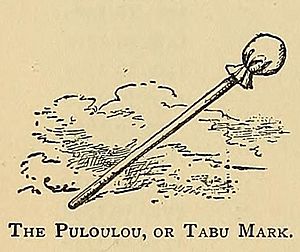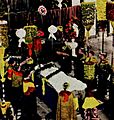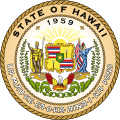Pūloʻuloʻu facts for kids
Pūloʻuloʻu (say: poo-loh-oo-LOH-oo) are special symbols from Hawaii. People sometimes call them "kapu sticks." These symbols show the power and importance of Hawaiian aliʻi (say: ah-LEE-ee), who were chiefs or royals. They also represent the ancestors who have passed away. Today, pūloʻuloʻu are still used. You can even see one on the Seal of the State of Hawaii.
The Story of Pūloʻuloʻu
Pūloʻuloʻu were very important in Ancient Hawaii. They showed the authority and protection of the aliʻi (chiefs). They also represented the mana (say: MAH-nah), which is the spiritual power of the chiefs.
These symbols were made by wrapping bundles of kapa cloth (a type of fabric) around a stick. Each pūloʻuloʻu was given an ancestral name. They were placed in important areas. They represented the ancestors of an aliʻi who had died and returned from Po (the Hawaiian idea of the spirit world or heaven). The round shape of the pūloʻuloʻu looked like stars from the Hawaiian perspective.
Sometimes, pūloʻuloʻu held special items. These could be small parts of deceased ancestors, like bones, teeth, or hair. This made them even more sacred. The idea of using pūloʻuloʻu as symbols of kapu (sacred rules or forbidden things) was brought to Hawaii by Paʻao. He was a high priest (kahuna nui) who came from Kahiki.
Where Pūloʻuloʻu Were Placed
Pūloʻuloʻu were often placed in important locations. You could find them at the home of an aliʻi. They were also placed at a heiau (say: HEH-ee-ow), which was a Hawaiian temple. Burial sites of the aliʻi also featured pūloʻuloʻu.
In 1883, a whaling captain named Alfred N. Tripp gave King Kalākaua a special pūloʻuloʻu. It was made from a narwhal tusk. This tusk was over seven feet long! It had a golden ball on top. Today, you can see this pūloʻuloʻu in the throne room of ʻIolani Palace. It stands between the thrones of King Kalākaua and Queen Kapiʻolani.
Pūloʻuloʻu are also displayed at the Royal Mausoleum of Hawaii at Mauna ʻAla. Here, they are placed inside the chapel. Metal versions of pūloʻuloʻu are also found outside the chapels and burial crypts.
Pūloʻuloʻu in Modern Symbols
The pūloʻuloʻu is a strong symbol of authority. Because of this, it is featured on the coat of arms of the Hawaiian Kingdom. It also appears on the seal of the State of Hawaii.
Gallery
-
Pūloʻuloʻu used at the funeral of Queen Liliʻuokalani
-
Metal representation of pūloʻuloʻu made with a narwhal tusk at ʻIolani Palace







